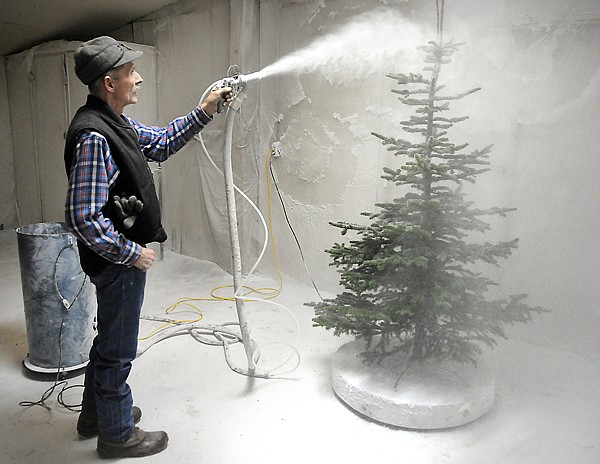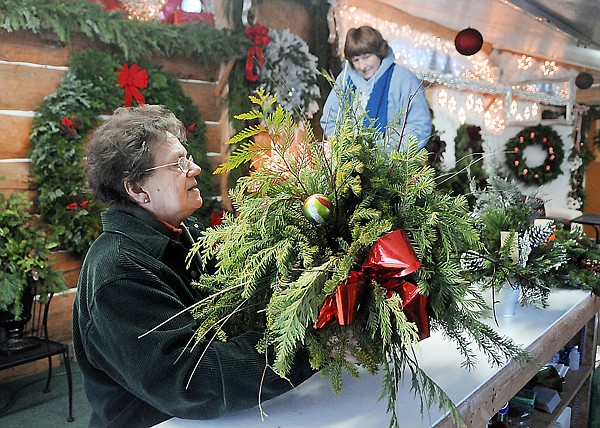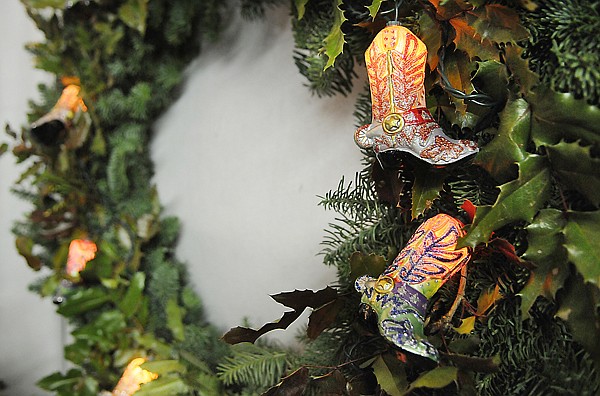Snow Line has good year, fabled past
Tom Little, owner of Snow Line Tree Co., called 2010 a fairly good year for selling Christmas trees in an industry that was once a giant in the Flathead.
“What enhanced it this year was this snow,” he said. “People couldn’t get out and cut trees.”
According to Little, Snow Line usually ends up with quite a few extra trees — but not this year. Little said his firm filled orders for tree sellers in Billings, Bozeman and Miles City where snow hit early and heavy with three- to four-feet accumulations.
“Those tree retailers all had a good season,” he said.
In early December, customers wandered through a thinning forest of wild and plantation-grown trees held erect by string from the rafters of Snow Line’s spacious indoor tree lot.
“When we start, we display 300 trees,” he said on a tour of the facility. “We used to raise horses and this was our riding arena.”
Little said his company on U. S. 93 South has the largest lot in Kalispell. Snow Line wrapped up sales for the season on Dec. 15.
In a shop off the indoor lot, Little’s wife Carolyn manages the sales of a wide variety of evergreens shaped as wreaths, candy canes, door swags, centerpieces and every other imaginable decor. Crews begin in mid-October making the pieces sold locally as well as shipped to distant doors.
In another room, special tables hold poultry netting that Snow Line crew weave with boughs to create blankets used to decorate graves, a custom widely practiced in Nebraska, Kansas, Oklahoma and Texas.
“We used to sell thousands of those,” he said. “Now we do close to a thousand.”
Little has witnessed massive changes in the industry that has been his life since his early 20s. He started out selling cherries in 1960 for Nate Boyd, one of the founders of Snow Line Tree Co..
“The company was started in 1955 by three local gentleman — Nate Boyd, Fred Larsen and Hank Marken,” he said. “Nate, being in the cherry business, had all these contacts with stores selling cherries back East. He got a foot in the door with produce managers to sell Christmas trees.”
At that time, the company operated out of the central cherry warehouse located where Kalispell Center Mall now stands. Most people can’t imagine the magnitude of the Christmas tree industry in those days.
Little recalled the scene at a railroad yard in Eureka in high tree-shipping season.
“I can remember 100 carloads of Christmas trees loaded to go to Chicago, Kansas City, New Orleans and Houston,” he said.
Each car held 3,500 to 4,000 tightly baled Christmas trees.
Kalispell and Eureka both proclaimed themselves the Christmas tree capital but Little said the industry thrived from Missoula to Kalispell to Libby to parts of British Columbia, including Cranbrook and Radium.
“We used to open tree yards in all those areas,” he said. “For example, down by Elmo, we had a tree yard where we would have 40,000 to 50,000 trees.”
In Eureka, Snow Line’s largest yard, Little can still visualize kids baling trees late into the night by the light of a kerosene lamp hung on a culled, stripped tree.
Back in the ’50s and ’60s, Snow Line annually shipped between 500,000 and 600,000 trees. The company also produced wreaths, roping, garlands and other products from 400,000 to 500,000 pounds of evergreen boughs.
“That produced a lot of jobs for guys who had access to the woods and a vehicle to transport the greens into town,” he said.
During the production season, the company still buys boughs from local people who cut a truck full then drive up on a scale to weigh their harvest for ready cash.
Even shipping half a million or more trees, Little said several competitors were larger than Snow Line half a century ago. He listed the majors in this area as Kirk, Hofert, Walters, Sortino and Montana Evergreen.
Even more people participated in the industry in a small way.
“There were lots of individuals that would cut a farm truck load of trees and go off to seek their fortune in California, Kansas and Texas,” he said with a laugh. “Some would come back with a sack full of money and some would come back with a sack full of I.O.U.s.”
Little said cutting trees provided the last chance for a lot of farmers and ranchers to put together some money for Christmas and to get them through the winter. He estimates that 5 million to 10 million trees were shipped out each year.
“It was really neat to see,” he said. “There aren’t many of us left that have been privileged to see that.”
Montana still produces wild Christmas trees from Kalispell to Eureka, Little said, but on a much smaller basis.
He became the owner of Snow Line in the late 1960s as each of the three owners reached retirement age and offered to sell him their stock. He relocated the business from leased quarters to about 30 acres he purchased off U.S. 93 South where he erected the signature green-and-white Quonset hut.
Of the major Christmas tree businesses from the early days, Snow Line Tree Co. is the lone survivor. The others went broke from failing to weather new trends.
Little recalled that the industry started to change in the ’60s when plantation trees came on the scene. Before that, all the trees were cut in the wild.
“The artificial Christmas tree was the worst thing that ever happened to our business,” he said.
Wild trees available for cutting also began to shrink between competing businesses and the government widening protected areas.
“There was a period in there that trees became a little harder to find,” Little said. “We had to expand our area and I spent a lot of time in what is called the Chilcotin area of B.C.”
Located about 1,000 miles north, Chilcotin hosts the Gang Ranch, a massive operation 300 miles long and 150 miles wide, where Little got access to wild trees. While most of that land is privately owned, the ranch had some islands of protected trees on government-owned land and timber.
“We got an education about what is called ‘crown land,’” he said with a laugh.
Little employed crews of local Pakistani tree cutters who worked hard but had a less-than-firm grasp on the English language. Unleashed in the forest, they stumbled into the off-limits crown land.
“We had quite an experience with the forestry department in Canada,” he said. “I thought we were all going to end up in jail. We finally made our peace with the land people.”
Another adventure began when Little met a Mexican national who came to Montana looking for Christmas trees to import. The two became close friends and Snow Line Tree Co. began shipping trees to Mexico where the industry is controlled by government permits.
One year, Little shipped trees but his $100,000 bill wasn’t paid. To find out what was holding up his payment, he flew to Mexico City to meet with officials of the government-controlled Bank of Commerce.
To his shock, an official insisted he had to import $100,000 in goods from Mexico to the United States before they would release his money. He rejected offers of hemp products and strawberries before finally agreeing to import cantaloupes.
A friend in the produce business in Chicago flew down to look over the crop in an extremely remote area. Little recalls their meeting with a foreman overseeing the men, women and children working the fields.
“He had two pearl-handled .45s strapped to his hip,” he said.
Little managed to get the deal done that year, but his experience the next year brought his south-of-the-border business dealings to an end. That was the year he and his Mexican partner secured all of the 350,000 government Christmas tree permits.
“So it was a big year for us in the ’80s,” Little said. “We put forth our biggest effort ever and shipped all the trees by rail. We had 10 carloads of trees that mysteriously disappeared.”
Little jumped on a plane and flew to Laredo and met with railroad officials. He soon learned it was hopeless as the only explanation he was ever given by the railroad was broken-down rail cars.
“It was my best year ever. I had cornered the market and it damn near broke me,” he said with a laugh. “I can laugh now but it wasn’t funny at the time.”
Snow Line survived where others didn’t by avoiding mistakes such as sending carloads of unsold trees to big cities on speculation. He also weathered the great Scotch pine crash that took down quite a few others.
“We went through a cycle when all the major tree companies came in the Flathead and started planting trees — primarily Scotch pines,” he said. “They were very popular in the ’60s, ’70s and into the ’80s.”
The demise of Scotch pines in favor of new plantation varieties was the final straw that took down major companies such as Walter and Hofert. Little and Snow Line have carried on growing trees on his Ferndale plantation and buying from other growers.
“Of the major trees cut on plantations, the big seller is Fraser fir,” Little said. “Grand firs are also popular.”
He said he wonders every year if he is planting the right variety. With eight to 10 years to grow a tree to maturity, growers make educated guesses and pray.
Coming off a good year in 2010 and surviving more than four decades, Little credits some providential intervention along with the hard work by his family and employees.
“The good Lord must have been looking over our shoulder,” he said.
Reporter Candace Chase may be reached at 758-4436 or by e-mail at cchase@dailyinterlake.com.










